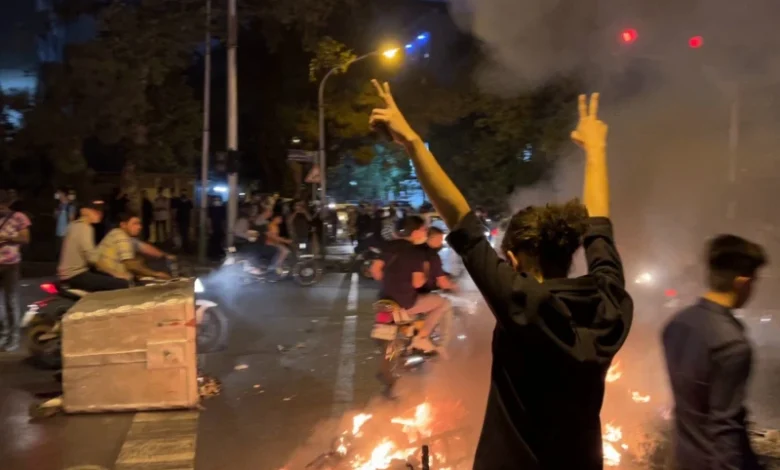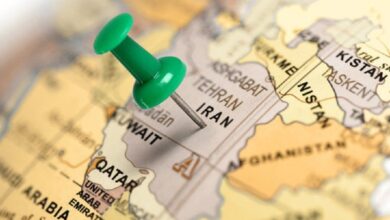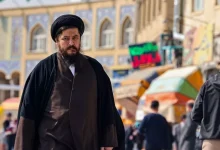
The escalating wave of protests shaking Iran since Sept. 17 isn’t the first time the country’s theocratic regime has faced mass unrest. However, the current upheavals are exceptional in scope and they show no signs of slowing down. The protests—which followed the death of a 22-year-old Kurdish-Iranian woman under custody of the morality police—aren’t confined to Tehran and other cities in the Iranian heartland but have engulfed remote border provinces as well. Within the provinces, demonstrations are taking place outside the capital cities in dozens of locations. Industrial workers and bazaar shopkeepers—important constituencies for the regime—have joined in as well. In another departure from past unrest, protesters have been fighting back against and even targeting police and security forces, who have killed hundreds of protesters. Over the weekend, Tehran’s notorious Evin prison was on fire with gunshots heard and several reported deaths. As it continues to intensify, this wave of demonstrations may pose the most formidable challenge to the regime since the immediate aftermath of Ayatollah Khomeini taking power in 1979.
Perhaps the most important aspect to the current uprising is the major role played by Iran’s ethnic minorities. According to BBC News, security forces have targeted and killed a disproportionate number of minority protesters, with a significant concentration of deaths in Baluchistan and the Caspian region in northwest Iran. Security forces perpetrated an outright massacre in Zahedan, a city near the border with Pakistan largely populated by Baluchs. On Sept. 30, regime forces killed over 80 Zahedan residents as they were leaving Friday prayers. Security forces wore traditional Baluch dress to avoid detection before opening fire on the worshippers. That this massacre was perpetrated on the Baluch minority went unmentioned in many Western media reports. Despite the massacre, the Baluchs held more anti-regime protests after prayers.
Iran’s history of ethnic grievances—especially in the non-Persian provinces dominated by Tehran—adds additional fuel to a highly combustible mix, and the regime’s harsh crackdown in Zahedan and elsewhere suggests that the regime is aware of this. Iran’s multiethnic nature is also an important part of Iranian politics, and it’s a source of potential upheaval that has been largely left out of debates outside Iran. Western experts and commentators tend to look at Iran through the eyes of its Persian elite, just like the West has long looked at Russia through the imperial eye of Moscow with little space for Ukrainian views, let alone Dagestani or Tatar ones. We ignore these realities—and the potential for internal conflict and disintegration—at our peril.
Non-Persian ethnic minorities—Azerbaijanis, Kurds, Arabs, Turkmens, Baluchs, and dozens more—make up more than half of Iran’s population, and they dominate vast regions of the country outside the Persian heartland that surrounds Tehran. Most of these minorities live in the border provinces and share ties with co-ethnics in neighboring states, such as Iraq, Azerbaijan, and Pakistan. Tehran forbids minorities to educate their children or receive government services in their native languages, but even so, according to Iranian government data, 40 percent of the country’s citizens aren’t even fluent in the Persian language. The official media and school textbooks often mock Iran’s minorities and employ racist tropes. Compared to the Persian-dominated center, Iran’s ethnic minorities face severe hardships—including poverty, poor access to government services, environmental degradation, and water shortages—likely reinforcing their sense of discrimination and depravation. Minorities experience higher rates of incarceration and execution. Activists and cultural figures who campaign for language and cultural rights are frequently arrested and convicted of national security crimes.
Get the full experience.
As anti-regime activity continues to progress, the role of the ethnic minorities will play an increasingly important role. The regime knows that many of the Persians dominating the Iranian opposition might hate the regime, but they hate the idea of losing control over the provinces even more. Tehran is already trying to appeal to Persian nationalist sentiment to try and split the opposition, stating that only the current government can keep control of the provinces. In playing the ethnic card, media and social media accounts linked to the Iranian Revolutionary Guards Corps have published maps of Iran broken up into ethnic provinces, warning the Persian nationalist opposition what could happen if the regime falls. Tehran’s missile strikes against Kurds in Iraq, which killed 13 people, were likely an attempt to tar-brush a homegrown uprising among Iranian Kurds as foreign interference. The regime is also trying to pit groups against each other, like Kurds and Azerbaijanis, who have longstanding disputes over land, water, and other resources.
Many Western journalists reporting on the protests seem to assume that since both Persians and non-Persians are calling for the end of the regime, they are united in their goals and that there is therefore no ethnicity-based challenge to the mullahs. These observers might remember that Russians, Ukrainians, Balts, Georgians, and others were also aligned in supporting the fall of the Soviet Union. But as soon as Moscow’s hold on its subjects was weakened, many of these groups pursued their national agenda, with local bonds of ethnicity, language, and culture stronger than the imperial center that once held its various conquered peoples together. Like Russia, Iran has its own imperial history, of which one legacy is the multiethnic tapestry spread across the map of Iran. And just like Western analysts largely ignored the imperial aspect of Moscow’s policies, Western observers are now largely ignoring the ethnic component of Tehran’s rule. Should the regime topple, there is no guarantee that the various groups will see their future with Tehran.
In recent years, confrontation between Iran’s ethnic minorities and the ruling regime has been on the rise. The violence is reciprocal: The regime targets ethnic minorities and vice versa. Since 2017, there has been an uptick in attacks on government targets, including the army and Iranian Revolutionary Guards Corps. Most of the attacks occur in largely non-Persian regions, including Sistan-Baluchistan, Khuzestan, Kurdistan, and West Azerbaijan. Baluch, Arab, and Kurd groups frequently strike Iranian forces stationed on the country’s borders. For instance, in October 2018, a Baluch group abducted 12 security personnel in Sistan-Baluchistan, which borders Pakistan. Kurdish insurgents have conducted attacks on Iranian soldiers and Iranian Revolutionary Guard Corps members.
In Iran’s border provinces, the personal security of the police and security service members is under direct threat. In the provinces, police officers and Iranian Revolutionary Guard Corps troops live in the towns they preside over, where they are less anonymous than in Tehran or other large cities. Local activists in many locations have made direct threats to police and security service members, warning of personal retribution if they harm the demonstrators. From abroad, opposition media has published the pictures and personal details of various local security officials participating in attacks against protesters, threatening the officers with retribution in hopes of intimidating government forces from further violence. In November 2021, Ahwaz Arab militants killed Iranian Revolutionary Guards Corps Col. Hadi Kanani, one of the main perpetrators of the deadly crackdowns against Ahwaz demonstrators in November 2019 and July 2021. According to Ahwaz activists in Iran, Kanani had been personally involved in the investigations and torture of Ahwaz political prisoners.
Significantly, the current wave of anti-regime unrest is taking place in provinces that have rarely witnessed anti-government demonstrations since the consolidation of the Islamic revolution in the early 1980s. This includes not just Baluchistan on the Pakistani border, but the Caspian Sea provinces of Gilan, Mazandaran, and Golestan, where the dominant ethnic groups are Gilaks, Mazandaranis, and Turkmens, respectively. In recent decades, the regime could count on the passivity of these provinces, even as anti-regime activity emerged in Tehran and other locations. Not this time.
Iran’s ethnic minorities could have a supersized impact on the success of anti-regime activity. Many of Iran’s most important strategic locations are located in areas inhabited by ethnic minorities. Iran’s main oil and natural gas production—and its major export ports—are in Khuzestan, where over half the population is ethnically Arab, with a long history of attempts at self-rule, in addition to a large Lur community. Iran’s strategic Chabahar Port lies in a Baluch majority area, and anti-regime activity in the port city has already created instability there.
If the regime collapses or loses the ability to control the provinces, elements of some of the ethnic groups could try to establish self-rule. This would not be new: It happened during the 1979 Islamic Revolution, when some of the major non-Persian ethnic groups—including Kurds, Turkmens, and Arabs—attempted to break away from Iran after the departure of the Shah, and the Azerbaijanis attempted to establish autonomy. The current regime and any potential replacement will oppose any change in Iran’s borders. In contrast to Moscow, which allowed most of the republics to go their own way after the Soviet collapse, the Iranian opposition cannot even agree on allowing minorities to teach their mother languages in schools, let alone have self-rule. That paves the way toward violent struggle should the regime collapse, affecting every state that borders Iran and leading to large-scale emigration to Europe and elsewhere. The United States, Europe, and Iran’s neighbors should keep a close eye on the relationship between the regime and Iran’s minorities—and prepare for a number of potential outcomes.







